Futurist Giorgio Sant' Angelo, An Hommage
Futurist Giorgio Sant' Angelo, An Hommage
By SUZAN MAZUR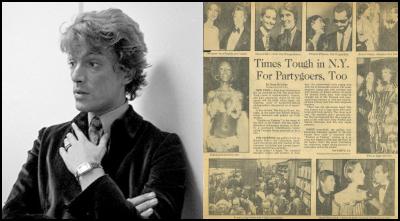
Click to enlarge
Giorgio Sant' Angelo, and Giorgio Sant' Angelo with Suzan Mazur (top left, Rizzoli party)
"I dream constantly. Mostly while I'm awake." -- Giorgio Sant' Angelo
In the mid 1970s when art inspired New York's fashion runways, there existed a stable of designers financed by Ben "Mr. Seventh Avenue" Shaw, among them avant garde talent Giorgio Sant' Angelo. Count Jorge Alberto Imperiale di Sant' Angelo e Ratti de Desio was Florentine by birth, a humanist with a piercing intelligence and generous laugh. No man (or woman) then on Seventh Avenue had blonde highlights as electric as his, or dared to wear a silk jacket cut quite so Italian.
I modeled for many of Shaw's designers around that time and recall thinking when first meeting Giorgio that I had never before seen anyone so alive.
One day Shaw, a great storyteller with Ari Onassis-type glasses, asked me to model the Sant' Angelo collection at 550 Seventh Avenue while Giorgio's model was out sick, and I increasingly ran into Giorgio over the next several days (including one night under the hairdryer at Gerard Bollei, wrapped in foil and bleach).
I was officially booked at Sant Angelo's 57th Street salon for a couple of weeks in December 1975 by my agent, Ellen Harth, the fomer Rudi Gernreich model. Giorgio saw his couture clients there -- Marisa Berenson, Zsa Zsa Gabor, Diana Ross, Lena Horne, the Jaggers. . .
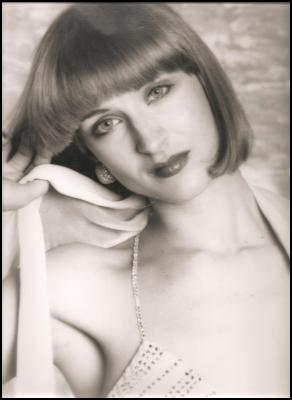
Click to enlarge
Suzan Mazur in Sant' Angelo, photo: Valentin '75
Giorgio Sant' Angelo grew up in Argentina, studied architecture and industrial design in Italy and art with Picasso, who, as the story goes, advised him to follow his restless creative energy. This led to Disney Studios and afterward a collaboration with Diana Vreeland in New York, who showcased his styling genius on the pages of Vogue. He is best known for his original, vibrant, body conscious designs and use of color. And for his celebration of indigenous cultures, Native American, Inca, Aztec.

Twiggy/Sant'Angelo/Richard Avedon
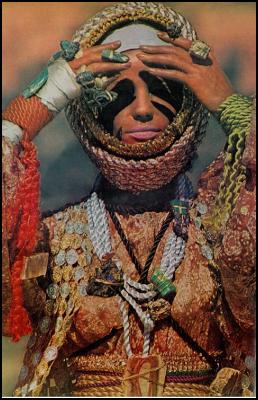
Veruschka/Sant'Angelo/Franco
Rubartelli
Of course, Giorgio was a friend of Andy Warhol's -- who didn't believe in fashion -- and the 70s art crowd. And he loved women and women loved him.
The 57th Street studio was a busy shop and I actually saw little of Giorgio. Some of it was a blur, and some back stage moments not appropriate to share. But he invited me one day to accompany him to the now-legendary Rizzoli "Fashion as Fantasy" party, which Roberto Polo organized.
Polo was a Cuban-born socialite and art collector, on a meteoric rise, later accused of misappropriating client investments and sent to prison in Lucca, Italy for four years.
Joining us was Belgian-born actress Monique Van Vooren, known for her role in Tarzan and the She Devil and Andy Warhol's Frankenstein.
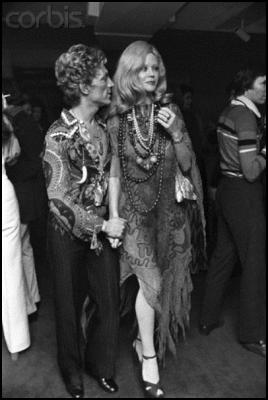
Giorgio with Monique Van Vooren
Polo told Diana McLellan, covering the event for the Washington Star (now defunct), the following:
"Fashion as Fantasy. . .will try to make a statement about fashion. It will be an exhibit about fashion, not a fashion exhibit. All the works in the exhibit, will, of course, not be works of art, including some by so-called regular artists. It will not attempt to be elegant or beautiful, because those attributes have a very superficial relationship to art, to works created with or without a purpose in a moment of self-expression."
I was a skeletal 114 pounds the night of the Rizzoli party in a Sant' Angelo beaded white dress. There was a sensuality to the weight of the beads, which was lovely. Giorgio told me that I reminded him of his sister in Cairo.
Monique wore "head to toe" silk chiffon. Rudi Gernreich's two models wore bicycle parts and the one wearing handlebars told me he planned to consume ten glasses of champagne before the night was over.
Following the "big, mad" Rizzoli black-tie affair, the entourage traveled by limousine to Nicola's for dinner on the Upper East Side. We then moved on to Tropicana where Andy Warhol was seated motionless in a peacock rattan chair, overseeing the room.
Giorgio loved to dance and we did. It's unclear now who led who but I had flashbacks to a time in the early 70s and St. Adrian's, dancing with blonde, glittery Eric Emerson -- the Magic Tramps singer and Warhol underground film star.
The morning after Rizzoli, Giorgio walked into my dressing room at his 57th Street studio, about the size of a closet, and kissed me. I remember feeling a bit like a bird. . .
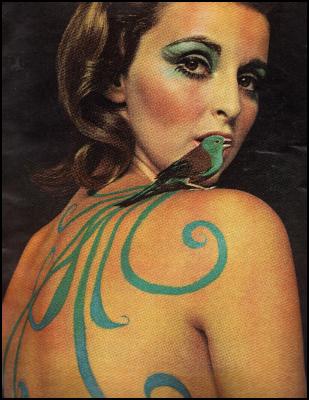
Giorgio's business was having serious cash flow problems by December 1975. I offered to introduce him to Dutch oil trader John Deuss, who financed the Alexandra Christie label I was the model for. Deuss thought Giorgio's clothes were "FANTASTIC!" but was horrified by the red ink on the balance sheet.
Later that winter, February 1976, I stopped by Giorgio's studio in primitivo attire, with friend and Soho News stylist Honey Wolters, now co-owner of Ruby Beets, Sag Harbor.
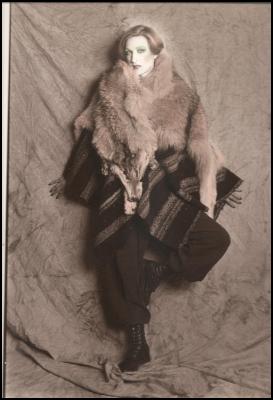
Click to enlarge
Suzan Mazur, New York '76
Giorgio told us of an upcoming fashion show traveling to Kuwait and Iran with 16 designer collections -- including two dozen of his pieces -- jewels from David Webb and the Estee Lauder chiefs. He suggested I contact the show's producers, which I did.
They invited me to model in the April Mid East tour celebrating the bicentennial of America. I accepted and booked out of the New York fashion shows that spring, to the objection of my agent Ellen Harth. Unbeknownst to me, Richard Helms, the former CIA Director was ambassador to Iran, had an interest in fashion and would attend the Tehran gala.
Channing Cassett, the Mid East show's organizer told New York Post society columnist Eugenia Sheppard women in the Gulf were "mad" for Giorgio's clothes, which was true. And he told Women's Wear Daily that Sant' Angelo's black Lycra spandex jumpsuit with multicolored ribbon trim was among the best sellers in Tehran.
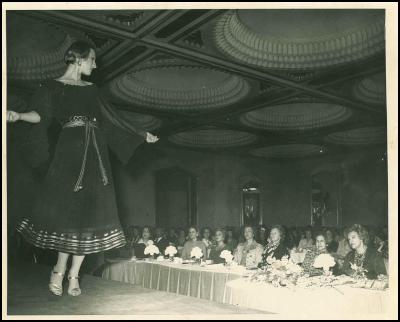
Click to enlarge
Suzan Mazur on Tehran Hilton runway, April '76, wearing Sant' Angelo peasant dress with the Empress's mother (far right) and Mrs. Richard Helms (third from right) looking on.
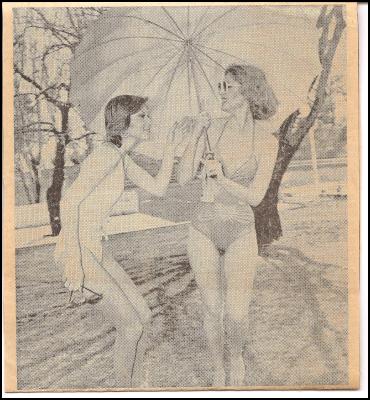
Click to enlarge
Giorgio's Swim Suits -
Gardens, Tehran Hilton, Tehran Journal
'76
When the US political climate changed following the Presidential election of Jimmy Carter, I began to think about returning to journalism, having left a writer/editor spot at Hearst Magazines in 1972. Omni magazine commissioned a "Future Fashion" story from me. Giorgio and I taped an interview for the piece in February 1979. He was thinking not only about future fashion, but designing useful household appliances, like a refrigerator that could double as an air conditioner. Excerpts from our interview follow.
Giorgio Sant' Angelo in conversation with Suzan Mazur, February 6, 1979:
"Way before the fabric, I think I have to have a little propeller which is going to take me places. . . No, not on wheels. Yes, sometimes on wheels. Sometimes you have to take me. I am an individual and I believe in individualism. That's why I don't like uniforms -- at all. Howsoever. Even as I believe in socialism, I don't believe in uniforms. Because with socialism you can be an individual. So I'm going to be myself. And I admire you for who you are. But if you are just like me, I'm not interested in you anymore. I'm not even interested in me anymore. So there must be a difference between people." . . .
"I would like to do costumes for a ballet where we can look at people flying individually with propellers. Being butterflies. That kind of ballet. . . My whole dream is flying, of course. But me, me, me, me. Gymnastics, trapeze and all that. And gliding. Being a kite is quite good. . . I dream constantly. Mostly while I'm awake." . . .
"Instead of civilizing the world we are uncivilizing it. Instead of creating beauty,we are creating horrors. Go and look back at Egypt. The Incas. The Chinese. They are much more highly developed than we are. Aesthetically also. And they knew how to dress -- with skirts. And they had the pyramids. So they could absorb the energy of the universe. . . Knew how to use the power of the universe instead of trying to capture the universe." . . .
"Computers. Forget them. They don't work. . . Because you must inform them every day. Because we change our minds every day. That's what a human being is all about." . . .
"I think human beings, we are survivors. . . We do usually develop things but immediately -- for today -- the car, the airplane. . . But get us out of cubicles! And Empire State Buildings! For sure. It [architecture] has to be always something that accommodates the geography of the Earth. That's very important. Our way of constructing buildings today has no relation [to the Earth]. . .
Sometimes I go to magnificent, beautiful places and I don't like them. . . Plus I would like to put bombs to everything. Get rid of all this ugliness, it's destroying the world." . . .
"The golden age is coming. And before the golden age comes, there are going to be serious, serious disasters. The world survives by itself. . . It's not so nice of me [to say] but I think half of the people of this world are going to disappear quite rapidly. War. And earthquakers [sic] and things. A lot of things are going to happen and we're going to be much less I hope. Much less." . . .
I was crushed to see the New York Times notice of Giorgio's death at age 56 in 1989.
Next month, Phoenix Art Museum will host a Sant' Angelo exhibit organized by Fashion Curator Dennita Sewell, formerly of the Costume Institute at New York's Metropolitan Museum of Art.
 Suzan Mazur is the author of The Altenberg 16: An Exposé of the Evolution Industry. Her reports have appeared in the Financial Times, The Economist, Forbes, Newsday, Philadelphia Inquirer, Archaeology, Connoisseur, Omni and others, as well as on PBS, CBC and MBC. She has been a guest on McLaughlin, Charlie Rose, and various Fox Television News programs. For some years along the way, she was a runway fashion model for Giorgio Sant' Angelo, Geoffrey Beene, Bill Blass and other legendary designers. Email: sznmzr @
aol.com
Suzan Mazur is the author of The Altenberg 16: An Exposé of the Evolution Industry. Her reports have appeared in the Financial Times, The Economist, Forbes, Newsday, Philadelphia Inquirer, Archaeology, Connoisseur, Omni and others, as well as on PBS, CBC and MBC. She has been a guest on McLaughlin, Charlie Rose, and various Fox Television News programs. For some years along the way, she was a runway fashion model for Giorgio Sant' Angelo, Geoffrey Beene, Bill Blass and other legendary designers. Email: sznmzr @
aol.com


 Binoy Kampmark: Fallibility, Dirty Wars And Pope Francis I
Binoy Kampmark: Fallibility, Dirty Wars And Pope Francis I Peter Dunne: Dunne's Weekly - An Issue No-one Can Afford To Lose
Peter Dunne: Dunne's Weekly - An Issue No-one Can Afford To Lose Martin LeFevre - Meditations: Choosing Mass Murder?
Martin LeFevre - Meditations: Choosing Mass Murder? Eugene Doyle: Quiet Mutiny - The U.S. Army Falls Apart
Eugene Doyle: Quiet Mutiny - The U.S. Army Falls Apart Gordon Campbell: Papal Picks, And India As A Defence Ally
Gordon Campbell: Papal Picks, And India As A Defence Ally Binoy Kampmark: The Selling Of America - Ending The US Dollar’s Exorbitant Privilege
Binoy Kampmark: The Selling Of America - Ending The US Dollar’s Exorbitant Privilege